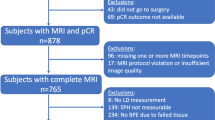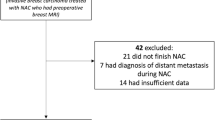Abstract
Objectives
To determine associations between dynamic contrast-enhanced MR imaging (DCE-MRI) parameters and survival intervals in patients with locally advanced breast cancer treated with neoadjuvant chemotherapy (NAC), surgery, and adjuvant therapies. Further, to compare the prognostic value of DCE-MRI parameters against traditional survival indicators.
Methods
DCE-MRI and MR tumour volume measures were obtained prior to treatment and post 2nd NAC cycle. To demonstrate which parameters were associated with survival, Cox’s proportional hazards models (CPHM) were employed. To avoid over-parameterisation, only those MR parameters with at least a borderline significant result were entered into the final CPHM.
Results
When considering disease-free survival positive axillary nodal status (hazard ratio [HR] 6.79), younger age (HR 3.37), negative oestrogen receptor status (HR 3.24), pre-treatment Maximum Enhancement Index (MaxEI) (HR 6.51), and percentage change in MaxEI (HR 1.02) represented the retained CPHM covariates. Similarly, positive axillary nodal status (HR 11.47), negative progesterone receptor status (HR 4.37) and percentage change in AUC90 (HR 1.01) represented the retained predictive variables for overall survival.
Conclusions
Multivariate survival analysis has demonstrated that DCE-MRI parameters obtained prior to NAC and/or post 2nd cycle can provide independent prognostic information that can complement traditional prognostic indicators available prior to treatment.
Key points
• MR-derived DCE-MRI parameters obtained prior to treatment have prognostic value.
• Early treatment-induced reductions in DCE-MRI parameters represents a positive prognostic indicator.
• DCE-MRI parameters provide independent prognostic information that can complement traditional prognostic indicators.


Similar content being viewed by others
References
Connolly RM, Stearns V (2013) Current approaches for neoadjuvant chemotherapy in breast cancer. Eur J Pharmacol 717:58–66
Kaufmann M, Hortobagyi GN, Goldhirsch A et al (2006) Recommendations from an international expert panel on the use of neoadjuvant (primary) systemic treatment of operable breast cancer: An update. J Clin Oncol 24:1940–1949
van de Hage JH, van de Velde CCJH, Mieog SJSD (2007) Preoperative chemotherapy for women with operable breast cancer. Cochrane Database Syst Rev Issue 2. Art. No.:CD005002. DOI: 10.1002/14651858.CD005002.pub2.
American Cancer Society (2014) Breast cancer survival rates by stage. [Online]. Available at: http://www.cancer.org/cancer/%20breastcancer/detailedguide/breast-cancer-survival-by-stage [Accessed: 4 February 2014].
Padhani AR, Khan AA (2010) Duffusion-weighted (DW) and dynamic contrast-enhanced (DCE) magnetic resonance imaging (MRI) for monitoring anticancer therapy. Target Oncol 5:39–52
Koo HR, Cho N, Song IC et al (2012) Correlation of perfusion parameters on dynamic contrast-enhanced MRI with prognostic factors and subtypes of breast cancer. J Magn Reson Imaging 36:145–151
Bone B, Szabo BK, Perbeck LG, Veress B, Aspelin P (2003) Can contrast-enhanced MR imaging predict survival in breast cancer? Acta Radiol 44:373–378
Partridge SC, Gibbs JE, Essermann LJ et al (2005) MRI measurements of breast tumour volume predict response to neoadjuvant chemotherapy and recurrence-free survival. Am J Roentgenol 184:1774–1781
Johansen R, Jensen LR, Rydland J et al (2009) Predicting survival and early clinical response to primary chemotherapy for patients with locally advanced breast cancer using DCE-MRI. J Magn Reson Imaging 29:1300–1307
Pickles MD, Manton DJ, Lowry M, Turnbull LW (2009) Prognostic value of pre-treatment DCE-MRI parameters in predicting disease free and overall survival for breast cancer patients undergoing neoadjuvant chemotherapy. Eur J Radiol 71:498–505
Heldahl MG, Bathen TF, Rydland J et al (2010) Prognostic value of pretreatment dynamic contrast-enhanced MR imaging in breast cancer patients receiving neoadjuvant chemotherapy: Overall survival prediction from combined time course and volume analysis. Acta Radiol 6:604–612
Li SP, Makris A, Beresford MJ et al (2011) Use of dynamic contrast-enhanced MR imaging to predict survival in patients with primary breast cancer undergoing neoadjuvant chemotherapy. Radiology 260:68–78
Tuncbilek N, Tokatli F, Altaner S et al (2012) Prognostic value DCE-MRI parameters in predicting factor disease free survival and overall survival for breast cancer patients. Eur J Radiol 81:863–867
Dietzel M, Zoubi R, Vag T et al (2013) Association between survival in patients with primary invasive breast cancer and computer aided MRI. J Magn Reson Imaging 37:146–155
Jones EF, Sinha SP, Newitt DC et al (2013) MRI enhancement in stromal tissue surrounding breast tumours: Association with recurrence free surivival following neoadjuvant chemotherapy. Plos One 8:1–8
Yi A, Cho N, Im S-A et al (2013) Survival outcomes of breast cancer patients who receive neoadjuvant chemotherapy: Associations with dynamic contrast-enhanced MR imaging with computer-aided evaluation. Radiology 268:662–672
Pickles MD, Lowry M, Manton DJ, Gibbs P, Turnbull LW (2005) Role of dynamic contrast enhanced MRI in monitoring early response of locally advanced breast cancer to neoadjuvant chemotherapy. Breast Cancer Res Treat 91:1–10
Hayes C, Padhani AR, Leach MO (2002) Assessing changes in tumour vascular function using dynamic contrast-enhanced magnetic resonance imaging. NMR Biomed 15:154–163
Chambers AF, Groom AC, MacDonald IC (2002) Dissemination and growth of cancer cells in metastatic sites. Nat Rev Cancer 2:563–572
Acknowledgments
The scientific guarantor of this publication is Dr. Martin Pickles. The authors of this manuscript declare no relationships with any companies, whose products or services may be related to the subject matter of the article. This study has received funding via the Yorkshire Cancer Research CMRI endowment. Victoria Allgar, BSc (hons) PhD CStat CSci, Senior Lecturer in Medical Statistics, Department of Health, Hull York Medical School, the University of York, kindly provided statistical advice for this manuscript. Institutional review board approval was not required because approval had previously been granted for the retrospective use of such data by the Research and Development Department of Hull & East Yorkshire Hospitals NHS Trust. Written informed consent was not required for this study because approval had previously been granted for the retrospective use of such data. Since this study did not involve any non-clinical research scans or the retrieval of non-clinical patient information, informed consent was not required. Some study subjects or cohorts have been previously reported in Eur J Radiol. 2009;71:498–505. However, not only has that original cohort been expanded from 54 to 86 subjects, but the follow-up interval is longer. Further, the prognostic value of the percentage change in MR parameters between pre-treatment and post-2nd neoadjuvant chemotherapy cycle is also considered in the current manuscript. Consequently, we believe the current work differs substantially from the earlier publication. Methodology: retrospective, diagnostic or prognostic study, performed at one institution.
Author information
Authors and Affiliations
Corresponding author
Rights and permissions
About this article
Cite this article
Pickles, M.D., Lowry, M., Manton, D.J. et al. Prognostic value of DCE-MRI in breast cancer patients undergoing neoadjuvant chemotherapy: a comparison with traditional survival indicators. Eur Radiol 25, 1097–1106 (2015). https://doi.org/10.1007/s00330-014-3502-5
Received:
Revised:
Accepted:
Published:
Issue Date:
DOI: https://doi.org/10.1007/s00330-014-3502-5




